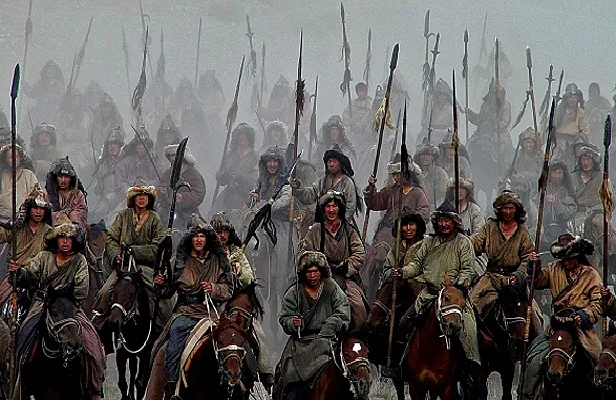After Genghis Khan’s death in 1227, his sons moved away from their father’s approach to army formation and began to include the troops of the conquered. This was inevitable, pure Mongol divisions would still not be enough for the vast territory from Uzbekistan to Lake Baikal.
In fact even at life of Genghis Khan 100 thousand Mongolian soldiers were a limit of possible. And it was necessary to subdue Russia and Europe, simultaneously to subdue the rest of China and still to have garrisons for suppression of revolts. Taking into account Batyi’s army in 100-120 thousand fighters, where the rest was to take?
Therefore, the share of the conquered in the Mongol army grew rapidly. And when in 1241 Batyi invaded Hungary from conquered Russia, he had only 50% of Mongols. And the rest of the warriors were Russians, Bulgars, Mordovians, Polovtsians, Alans, and Kirghiz. Only one thing remained unchanged — the imperial guard.

While Genghis Khan was still alive, the Mongols conquered a huge territory. And they had only 100 thousand soldiers in the army. Calling the troops of the conquered into the army was inevitable
Personal guard for his family Genghis Khan received from his father. Each leader in Transbaikalia had a detachment of bodyguards turkhouts, they are mentioned in «The Hidden Tale of the Mongols» of the 13th century. In conditions of eternal enmity of Mongolian tribes, Genghis Khan turned a small detachment into a whole guard division (tumen) of 10 thousand sabers called «keshik».
Warriors of keshik — «keshikten», became the chain dogs of the Golden Kin of Genghisid, their personal imperial guard. Only «noyons» (chiefs) of Mongolian tribes could enter the keshik. And having entered, the chiefs became privates, regardless of honor, money or hubris. Promotion went by further merit.

Genghis Khan created an entire tumen of elite Mongols. And called the personal guard — «keshik»
Depending on talents, muscles and fighting skills guards were divided into three groups: turkhouts — day guard, kebteul — night guard and khorchin — skilled archers. Turkhauts and khorchins became the marching guards of khans, they were the most numerous. Kebteuls evolved into adjutants, secretaries, lords of the night pots, knew all the secrets of the master.
Keshikten stood in the Mongol army above the common soldiers, a private guard was equal to a centurion, and a centurion to a thousandaire. Their orders were binding on everyone, and only the commander of the guard, the Temnik (general) or the Mongol khan could order them.

Each son or grandson of Genghis Khan had his own piece of the Imperial Guard
Each son and grandson of Genghis Khan had his own piece of the keshik, although most of the tumen guarded the emperor of the Mongol Empire in the capital Karakorum. Therefore, in the Western campaign of the Mongols, into which the sons and grandsons of Genghis Khan went, each had a personal guard piece. This included Batyi’s.
Chronicles have left us no evidence that in the invasion of Russia and Europe the Mongol guards were sent into battle. It was not their job to fight, the precious khans did not go into battle, they were saving themselves for a beautiful future. But in those cases, when it came to a personal battle of the Chinggisids, next to necessarily fought Mongolian guardsmen.

The last emperor of Mongols by name Khubilay will dissolve the guard tumen
So it was in battle near Kolomna 1238 where trying to break stubborn Russian redoubt died Kyulkhan, son of Genghis Khan. Probably so was and in battle on the river Shayo in Hungary where Genghisids personally led tumens in terrible meat grinder.
With the collapse of the Mongol Empire into separate states of Genghis Khan’s grandsons, such as the Golden Horde, the Guard Mongolian Tumen also collapses. Each separatist state develops a local guard, and the last mention of the Keshikten is found under Emperor Khubilai in 1269. But even Khubilai, founding a new Yuan dynasty in China, abandoned his Mongolian roots.
